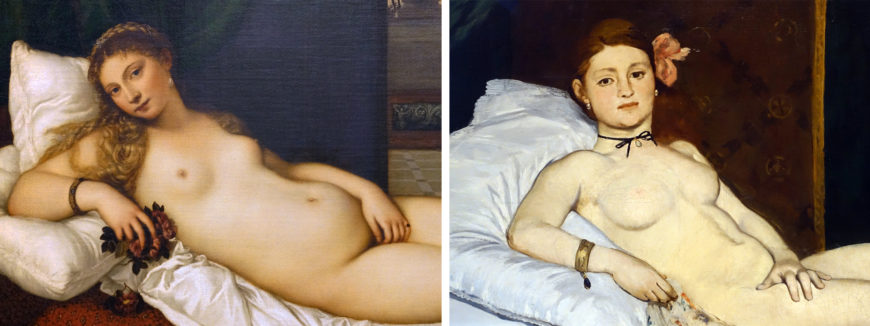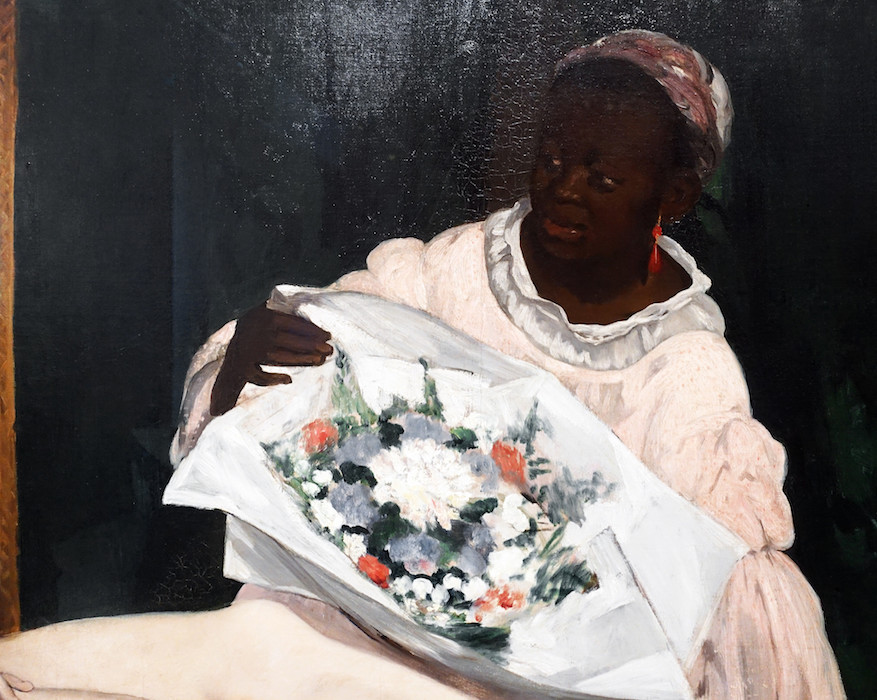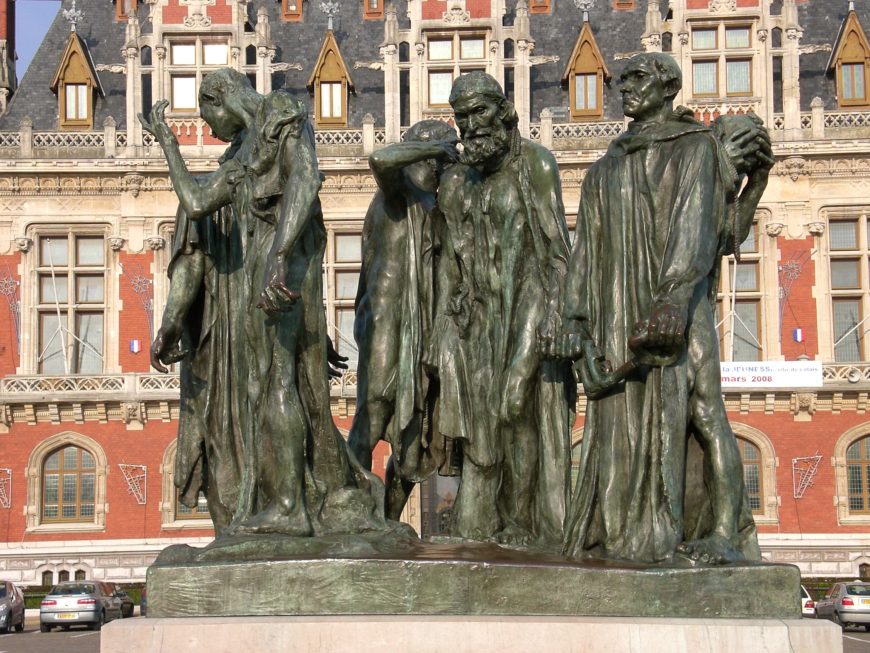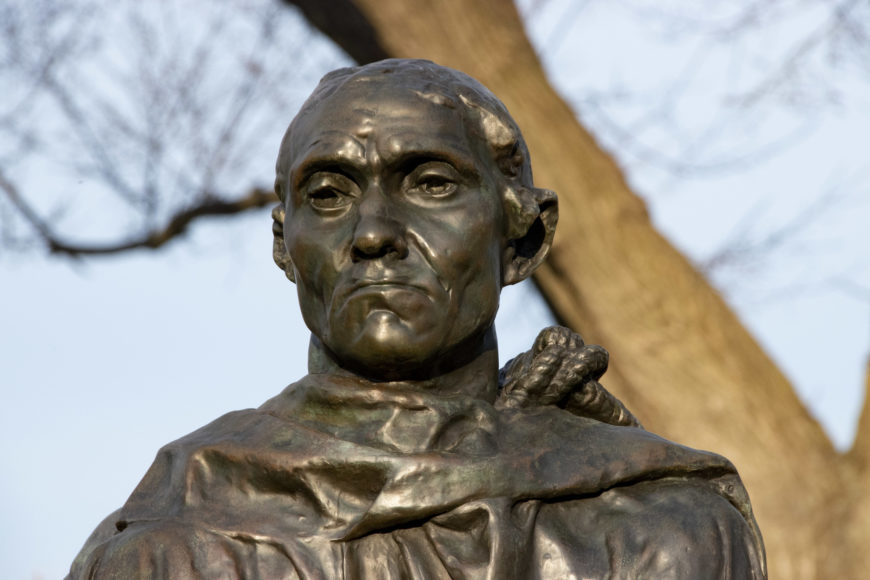9.3 Visual Arts
Visual Arts: Realism
The Modern Era begins with the Industrial Revolution in the late eighteenth century. Clothing, food, heat, light and sanitation are a few of the basic areas that “modernized” the nineteenth century. Transportation was faster, getting things done got easier, shopping in the new department stores became an adventure, and people developed a sense of “leisure time”—thus the entertainment businesses grew.
In Paris, the city was transformed from a medieval warren of streets to a grand urban center with wide boulevards, parks, shopping districts and multi-class dwellings (so that the division of class might be from floor to floor—the rich on the lower floors and the poor on the upper floors in one building—instead by neighborhood).
Therefore, modern life was about social mixing, social mobility, frequent journeys from the city to the country and back, and a generally faster pace which has accelerated ever since.
Gustave Courbet, Bonjour Monsieur Courbet
Arguably the most influential artist of nineteenth century French Realism, Gustave Courbet (goos-tav core-bay), is the first major figure that we can identify as avant-garde (ahh-vahhnt guard). This was originally a French military term subsequently adopted for certain radical artists and thinkers. “Avant” means advance or forward, and “garde” is similar to the English guard or soldier, so the original phrase referred to the vanguard or the troops that pushed ahead of the main battalions at great personal risk. In the art world, avant-garde refers to those artists willing to risk their reputations in search of new methods of visual expression that break down old, ineffective approaches to art-making. The avant-garde is always ahead of the pack, but their new ideas, if ultimately successful, are often adopted by the masses.
In his canvas The Meeting or, Bonjour Monsieur Courbet, of 1854, Courbet has painted himself on the right side. This self-portrait offers a number of significant clues as to how the artist thought of himself or perhaps how he wished to be seen. Rather like dressing in the morning or applying makeup (if you do), a self-portrait allows for a degree of control over the way that others perceive you.
Courbet, then, is announcing who he is. Our job is to read the clues that this image offers. Looking closely at the painting, Bonjour Monsieur Courbet, what visual cues help identify each person? Before you say to yourself, “I don’t know how to do this,” remember that you are in fact an expert in reading the clues given by the people around you. Everyday you respond to body language, types and styles of clothing, facial expression, hand gesture, and environmental context. Those judgments are based upon your quick, and quite sophisticated assessment of these sorts of clues. So look at these figures as actors on a stage or, as Courbet has suggested, people that you’ve run across as you stroll a country road. What do the costumes, the props, and the interactions express?
The man in the green jacket beside the dog is very well dressed indeed. But is the man in brown next to him? He wears a suit, but it is worn and ill-fitting. His name is Calas and he serves the man beside him. The rich man in the center is flanked by both his servent Calas and his dog. Is Courbet trying to draw a connection between this man and the dog as well as a distinction between himself and the group of three? Do you see this as a chance meeting? And what of the angle of the heads?
Look closely at the angle of Courbet’s head in relation to the angle of the servant. The fellow in green is the son of a banker, an industrialist named Alfred Bruyas who is one of Courbet’s patrons and had himself been a painter. Bruyas has also removed his right glove, presumably to shake Courbet’s hand, Courbet has not returned the gesture. The patron and artist, though, are unfairly matched, since Bruyas is on Courbet’s turf.
We know that Courbet came from Ornans in eastern France, quite outside of the orbit of Paris where he had moved. But here, Courbet is self-sufficient, and carries on his back a folding easel that contains everything he needs (paint, canvas, palette, oil, turpentine, and rags) to paint directly from nature. Bruyas, on the other hand, must be trailed by a servant and carries only a small cane. One can imagine that Bruyas and his servant had been transported by the carriage in the background, ill-prepared as they are for the countryside, while Courbet had evidently been making his way on foot.
The meeting between the two men represents the vitality of the countryside in contrast to the mannered style of the city. Even the different treatment of Bruyas and Courbet’s beards, though related to each man’s true likeness, further underscores the contrast of the stuffy aesthete to the “worker-artist.” The issue we’ve discussed before–the exaltation of the countryside as the Industrial Revolution progressed–sees its full expression in this work. This, then, really is Courbet’s manifesto. Here is the artist, a man of the country who goes his own way.
Unlike the other great painters of rural life and labor, such as the French Realist Jean-François Millet, the artist Gustave Courbet was very politically active. In 1848, he witnessed and read about a series of unsuccessful uprisings in France, England, and Germany. These revolts had been inspired by earlier enlightenment thinking. Unlike the American and French Revolutions of the eighteenth century, however, these more modern actions were fueled by the depravations and mass dislocations caused by the industrialization of Western Europe. Laissez-faire capitalism of the nineteenth century built both massive fortunes and the slums of the wretchedly poor. And life was indeed wretched for most.
When we think of the economic system currently employed in the United States, we think of modern capitalism. After all, the planned socialist economies of the “Iron Curtain” (the Soviet Union and its allies), have been discredited. However, before we come to feel too smug, we should remember that our system is actually is a highly socialized capitalism, which is a very good thing. As stated earlier, pure capitalism is brutal. This period saw young children chiseling coal from tunnels too narrow for adults and the common use of poisonous substances without even rudimentary safeguards required for workers. There was no safety net beyond one’s family and church. Many died of neglect, starvation, and disease.
Copyright: Dr. Beth Harris and Dr. Steven Zucker, “Gustave Courbet, Bonjour Monsieur Courbet,” in Smarthistory, August 9, 2015, accessed June 17, 2024, https://smarthistory.org/courbet-bonjour-monsieur-courbet/.
Édouard Manet, Olympia
Video URL: https://youtu.be/nFhgy9mkNRo?si=icu5yNI8u_R_OEeg
Olympia features a nude woman reclining upon a chaise lounge, with a small black cat at her feet (image above), and a Black female servant behind her brandishing a bouquet of flowers (image below). It struck viewers—who flocked to see the painting—as a great insult to the academic tradition. And of course it was. One could say that the artist had thrown down a gauntlet. The subject was modern—maybe too modern, since it failed to properly elevate the woman’s nakedness to the lofty ideals of nudity found in art of antiquity —she was no goddess or mythological figure. As the art historian Eunice Lipton described it, Manet had “robbed,” the art historical genre of nudes of “their mythic scaffolding…”[1] Nineteenth-century French salon painting (sometimes also called academic painting—the art advocated by the Royal Academy) was supposed to perpetually return to the classical past to retrieve and reinvent its forms and ideals, making them relevant for the present moment. In using a contemporary subject (and not Venus), Manet mocked that tradition and, moreover, dared to suggest that the classical past held no relevance for the modern industrial present.
As if to underscore his rejection of the past, Manet used as his source a well-known painting in the collection of the Louvre—Venus of Urbino, a 1538 painting by the Venetian Renaissance artist Titian (image above)—and he then stripped it of meaning. To an eye trained in the classical style, Olympia was clearly no respectful homage to Titian’s masterpiece; the artist offered instead an impoverished copy. In place of the seamlessly contoured voluptuous figure of Venus, set within a richly atmospheric and imaginary world, Olympia was flatly painted, poorly contoured, lacked depth, and seemed to inhabit the seamy, contemporary world of Parisian prostitution.
Why, critics asked, was the figure so flat and washed out, the background so dark? Why had the artist abandoned the centuries-old practice of leading the eye towards an imagined vanishing point that would establish the fiction of a believable space for the figures to inhabit? For Manet’s artistic contemporaries, however, the loose, fluid brushwork and the seeming rapidity of execution were much more than a hoax. In one stroke, the artist had dissolved classical illusionism and re-invented painting as something that spoke to its own condition of being a painted representation.

Manet had created an artistic revolution: a contemporary subject depicted in a modern manner. It is hard from a present-day perspective to see what all the fuss was about. Nevertheless, the painting elicited much unease and it is important to remember—in the absence of the profusion of media imagery that exists today—that painting and sculpture in nineteenth-century France served to consolidate identity on both a national and individual level. And here is where the Olympia’s subversive role resides. Manet chose not to mollify anxiety about this new modern world of which Paris had become a symbol. For those anxious about class status (many had recently moved to Paris from the countryside), the naked woman in Olympia coldly stared back at the new urban bourgeoisie looking to art to solidify their own sense of identity. Aside from the reference to prostitution—itself a dangerous sign of the emerging margins in the modern city—the painting’s inclusion of a Black woman tapped into the French colonialist mindset while providing a stark contrast for the whiteness of Olympia. The Black woman also served as a powerful emblem of “primitive” sexuality, one of many fictions that aimed to justify colonial views of non-Western societies.

If Manet rejected an established approach to painting that valued the timeless and eternal, Olympia served to further embody, for his scandalized viewers, a sense of the modern world as one brimming with uncertainty and newness. Olympia occupies a pivotal moment in art history. Situated on the threshold of the shift from the classical tradition to an industrialized modernity, it is a perfect metaphor of an irretrievably disappearing past and an as yet unknowable future.
Copyright: Dr. Thomas Folland, “Édouard Manet, Olympia,” in Smarthistory, December 9, 2015, accessed June 17, 2024, https://smarthistory.org/edouard-manet-olympia/.
Édouard Manet, Le déjeuner sur l’herbe (Luncheon on the Grass)
Video URL: https://youtu.be/3xBGF8H3bQ4?si=_JlHpDzLn5oJ93jX
Impressionism
The group of artists who became known as the Impressionists did something ground-breaking in addition to painting their sketchy, light-filled canvases: they established their own exhibition. This may not seem like much in an era like ours, when art galleries are everywhere in major cities, but in Paris at this time, there was one official, state-sponsored exhibition—called the Salon—and very few art galleries devoted to the work of living artists. For most of the nineteenth century then, the Salon was the only way to exhibit your work (and therefore the only way to establish your reputation and make a living as an artist). The works exhibited at the Salon were chosen by a jury—which could often be quite arbitrary. The artists we know today as Impressionists—Claude Monet, August Renoir, Edgar Degas, Berthe Morisot, Alfred Sisley (and several others)—could not afford to wait for France to accept their work. They all had experienced rejection by the Salon jury in recent years and felt that waiting an entire year between exhibitions was too long. They needed to show their work and they wanted to sell it.
The artists pooled their money, rented a studio that belonged to the photographer Nadar, and set a date for their first collective exhibition. They called themselves the Anonymous Society of Painters, Sculptors, and Printmakers and their first show opened at about the same time as the annual Salon in May 1874. The Impressionists held eight exhibitions from 1874 through 1886.
The impressionists regarded Manet as their inspiration and leader in their spirit of revolution, but Manet had no desire to join their cooperative venture into independent exhibitions. Manet had set up his own pavilion during the 1867 World’s Fair, but he was not interested in giving up on the Salon jury. He wanted Paris to come to him and accept him—even if he had to endure their ridicule in the process.
Monet, Renoir, Degas, and Sisley had met through classes. Berthe Morisot was a friend of both Degas and Manet (she would marry Édouard Manet’s brother Eugène by the end of 1874). She had been accepted to the Salon, but her work had become more experimental since then. Degas invited Morisot to join their risky effort. The first exhibition did not repay the artists monetarily but it did draw the critics, some of whom decided their art was abominable. What they saw wasn’t finished in their eyes; these were mere “impressions.” This was not a compliment. The paintings of Neoclassical and Romantic artists had a finished appearance. The Impressionists’ completed works looked like sketches, fast and preliminary “impressions” that artists would dash off to preserve an idea of what to paint more carefully at a later date. Normally, an artist’s “impressions” were not meant to be sold, but were meant to be aids for the memory—to take these ideas back to the studio for the masterpiece on canvas. The critics thought it was absurd to sell paintings that looked like slap-dash impressions and to present these paintings as finished works.
Courbet, Manet and the Impressionists also challenged the Academy’s category codes. The Academy deemed that only “history painting” was great painting. These young Realists and Impressionists questioned the long established hierarchy of subject matter. They believed that landscapes and genres scenes (scenes of contemporary life) were worthy and important. In their landscapes and genre scenes, the Impressionist tried to arrest a particular moment in time by pinpointing specific atmospheric conditions—light flickering on water, moving clouds, a burst of rain. Their technique tried to capture what they saw. They painted small commas of pure color one next to another. When viewer stood at a reasonable distance their eyes would see a mix of individual marks; colors that had blended optically. This method created more vibrant colors than colors mixed as physical paint on a palette. An important aspect of the Impressionist painting was the appearance of quickly shifting light on the surface of forms and the representation changing atmospheric conditions. The Impressionists wanted to create an art that was modern by capturing the rapid pace of contemporary life and the fleeting conditions of light. They painted outdoors (en plein air) to capture the appearance of the light as it flickered and faded while they worked.
By the 1880s, the Impressionists accepted the name the critics gave them, though their reception in France did not improve quickly. Other artists, such as Mary Cassatt, recognized the value of the Impressionist movement and were invited to join. American and other non-French collectors purchased numerous works by the Impressionists. Today, a large share of Impressionist work remains outside French collections.
Copyright: Dr. Beth Gersh-Nesic, “Impressionism, an introduction,” in Smarthistory, August 9, 2015, accessed June 17, 2024, https://smarthistory.org/a-beginners-guide-to-impressionism/.
Edgar Degas, The Dance Class
Video URL: https://youtu.be/NigP3DjV3NY?si=bWcQlK6-ORu2gptO
Berthe Morisot, The Cradle
Video URL: https://youtu.be/na05-xCZR8s?si=2ECJ5HrwzjidOGI9
Auguste Renoir, Moulin de la Galette
Video URL: https://youtu.be/o6amlRsb1n4?si=gSqeskO2EJRnfzba
Auguste Renoir, Luncheon of the Boating Party
Video URL: https://youtu.be/feCG2zfzflo?si=OgD5-Rh9Qo8RKUuE
Claude Monet, Rouen Cathedral Series
Video URL: https://youtu.be/DWHJx0kFQCo?si=fvLxjgxsfhCtKuPD
Claude Monet, Les Nymphéas (The Water Lilies)
Video URL: https://youtu.be/6fHorNn2zqQ?si=LiIPsOKNiadyzVWF
Georges Seurat, A Sunday on La Grande Jatte – 1884
Video URL: https://youtu.be/wNB9Vm6MoDQ?si=37NIPMR6-Ca5Rz9W
Vincent van Gogh, The Starry Night
Video URL: https://youtu.be/ndwOgL3ZgCQ?si=kxJcTsNv8aSqMWLe
Paul Cézanne, Bathers (Les Grandes Baigneuses)
Video URL: https://youtu.be/iQY3SdZeZ6g?si=jI2XeMsdA5pxCaRh
Auguste Rodin, The Burghers of Calais

In 1885, Rodin was commissioned by the French city of Calais to create a sculpture that commemorated the heroism of Eustache de Saint-Pierre, a prominent citizen of Calais, during the dreadful Hundred Years’ War between England and France (begun in 1337).
We see six men covered in simple layers of tattered sackcloth; their bodies appearing thin and malnourished with bones and joints clearly visible. Each man is a burgher, or city councilmen, of Calais, and each has their own stance and identifiable features. However, while they may stand together with a sense of familiarity, none of them are making eye contact with the men beside them. Some figures have their heads bowed or their faces obscured by raised hands, while others try to stand tall with their eyes gazing into the distance. They are drawn together not through physical or verbal contact, but by their slumped shoulders, bare feet, and an expression of utter anguish.
Rodin followed the recounting of Jean Froissart, a fourteenth-century French chronicler, who wrote of the war. According to Froissart, King Edward III made a deal with the citizens of Calais: if they wished to save their lives and their beloved city, then not only must they surrender the keys to the city, but six prominent members of the city council must volunteer to give up their lives. The leader of the group was Eustache de Saint-Pierre, who Rodin depicted with a bowed head and bearded face towards the middle of the gathering. To Saint-Pierre’s left, with his mouth closed in a tight line and carrying a giant set of keys, is Jean d’Aire. The remaining men are identified as Andrieu d’Andres, Jean de Fiennes, and Pierre and Jacques de Wissant.

Unbeknownst to the six burghers, at the time of their departure, their lives would eventually be spared. However, here Rodin made the decision to capture these men not when they were finally released, but in the moment that they gathered to leave the city to go to their deaths. Instead of depicting the elation of victory, the threat of death is very real. Furthermore, Rodin stretched his composition into a circle causing no one man to be the focal point which allows the sculpture to be viewed in-the-round from multiple perspectives with no clear leader.
While these six men, at first glance, may look fragile, the heavy, rhythmic drapery that hangs from their shoulders falls to the ground like lead weights, anchoring them and creating a mass of strong, unyielding bodies.

In fact, the fabric appears to almost fused to the ground—conveying the conflict between the men’s desire to live and the need to save their city. Rodin included raised portions of the floor under the men’s feet which would have, ultimately, made some of the men appear higher than others, yet they are all sculpted to be around the same height, that of an adult male. The burghers were not meant to be viewed in the form of a hierarchal pyramid with Eustache de Saint-Pierre at the top, which would have been typical in a multi-figure statue, but as a group equal in status. By bringing these men down to ‘street level,’ Rodin allowed the viewer to easily look up into the men’s faces mere inches from his/her own; enhancing the personal connection between the viewer and the six men.
Because the patrons wanted a heroic quality, with a raised pedestal that would place the figures in a God-like status high above the viewers, Rodin presented the city of Calais with The Burghers of Calais complete with a pedestal. However, the raised pedestal did not allow an audience to view the work of art as Rodin had intended. Therefore, he created a second version, one lacking a pedestal, to be placed at the Musée Rodin at the Hôtel Biron in Paris. Rodin’s goal was to bring the audience into his sculpture of The Burghers of Calais, and he accomplished this by not only positioning each figure in a different stance with the men’s heads facing separate directions, but he lowered them down to street level so a viewer could easily walk around the sculpture and see each man and each facial expression and feel as if they were a part of the group, personally experiencing the tragic event.
Throughout his career, Rodin took risks and created his works of art in his own, albeit unconventional, way. As a result, Rodin set a standard for artists who came after him and his Burghers of Calais became one of his most well-known and studied works.
Copyright: Elisabeth Rowney, “Auguste Rodin, The Burghers of Calais,” in Smarthistory, August 9, 2015, accessed June 17, 2024, https://smarthistory.org/rodin-the-burghers-of-calais/.

